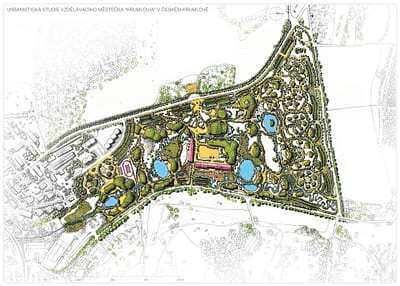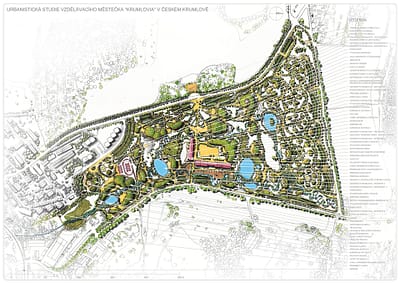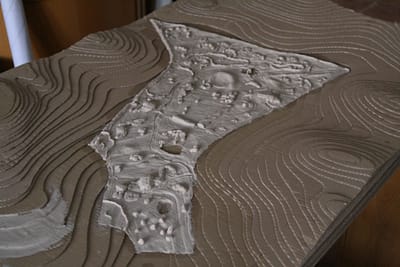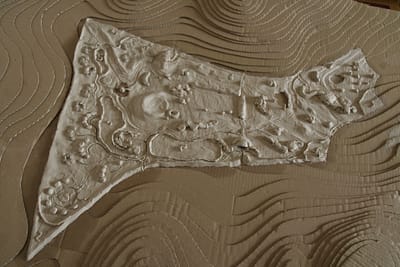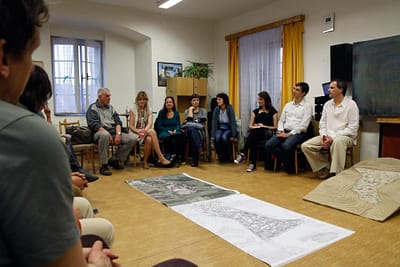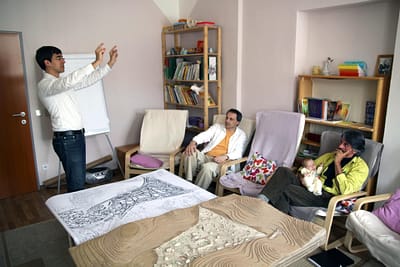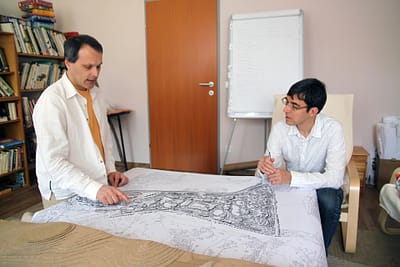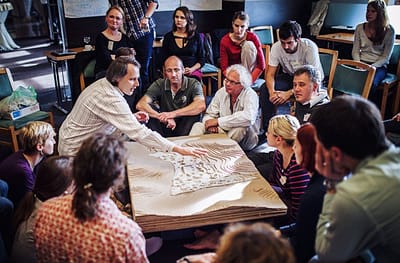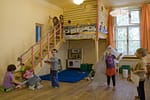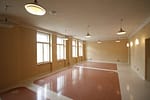The intention of the creative group led by prof. Gaudenz Assenza was to offer to the city of Český Krumlov a vision of an educational complex in the Vyšný locality. Creating architectural concept was led by acad. arch. Oldřich Hozman.
The main architectural vision of the Krumlovia Project was to develop artistically sophisticated organic architecture with attention to details. The architecture of the buildings leads to openness both to others and to oneself. Since the educational village will provide opportunities for lifelong learning for present and future generations, the architecture should support a wide range of teaching / creative processes and educational approaches.
We believe that the environment and its contents interact with each other (the witnesses of this fact are e.g. the Universities of Oxford or Cambridge). Achieving creative results in a non-creative environment is difficult. Therefore, we wish to build artistic and natural environment that will support learning and life itself in all its dimensions.
The environment will be shaped by architects, artists, and top craftsmen. Each architectural element of the educational village should have its sense and it should tell a story. The buildings and parks will cultivate aesthetic perception and arouse curiosity through natural and pleasant shapes, colours, lights, and materials. The architecture will support both physical and mental health of users and visitors of the buildings. The buildings will be energy efficient. The campus will be built in accordance with the standards of sustainability, self-sufficiency, and smart specialization, which will be current at the time of the construction.
Most of the buildings will have one floor; the maximum in exceptional cases will be three floors. The buildings will usually have grassed roofs and lightened interiors; built close to one another, usually organized into smaller groups. It will allow creating and experiencing relationships between neighbours. In parks and buildings, there will be secluded places offering the possibility of relaxation and meeting in groups. Different generations will live so close to one another so that young and old people can naturally work and visit one another. Such an environment supports concern for others. In various parts of the park, there will be enclosures for smaller animals.
We draw inspiration and ideas from many architecture schools and trends. We consider it beneficial for the overall concept and its rendering to be intelligible, aesthetically compact and meaningful. We find this sense in organic architecture, by connecting the artistic architecture with ecological and deeper holistic principles.
The architecture in the premises will rely on the organic shapes of live nature in harmony with clean geometric shapes that can be found for example in minerals and crystals. The shapes will be pleasant, not artificially constructed. The buildings and gardens throughout the entire premises will be inspired by living and changing nature. The artistic adaptation of the buildings and parks will cultivate human qualities, deepen interest in the environment, attention and care for the nature.
Architecture does not affect only the physical body, but the whole human individuality. In short, the architecture supports holistic development of a human being. Architecture therefore also affects human behaviour. Artistic and natural features in architecture can help to develop healthy attitudes of people.
Organic architecture supports physical and mental health. When a person perceives it, they are experiencing gradual development of successive shapes. The successive and gradually transforming shapes create sensually rich experiences in the perception of the viewer. Senses are activated, which has healing effect on body functions.
Organic architecture seeks to contribute to the most important things the educational village of Krumlovia can provide – to the improvement of social and individual effects of people to their environment and also to one another. The human psyche is positively influenced by aesthetically harmonizing environment and style. If people are exposed to such environment, their behaviour softens over the time and they become more receptive. That is why the architecture and parks in the area will have a nature-inspired character inspired by living, ever-changing nature.
Gaudenz Assenza and Oldřich Hozman
Study
Creation of the model
It is important to involve as many future users as possible in the design creation. When working on a model, circumstances that one would not take into account will emerge from the work on the model…In this process it was allowed for the general public to participate.

